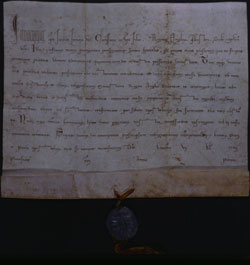 |
 |
 |
 |
 |
 |
 |
|
Visitors (6/7) Visitors may have occupied the area to the rear of the lay-brothers’ choir, the furthest position from the High Altar. The Cistercians did not encourage outsiders and forbade their admittance to the Hours, Mass and Communion, but there were times when visitors were anticipated. The twelfth-century Customs acknowledge their possible presence on great occasions such as Palm Sunday, Ash Wednesday, Easter and the Purification of Mary (2 August),(14) and their probable attendance at the Blessing of the Water on Sundays.(15) Women were initially strictly forbidden from entering the Cistercian precincts, but by the mid-twelfth century external pressure forced the General Chapter to modify its position and allow women to enter the church on the day of its dedication, or within the octave. This concession did not extend to those who were breast-feeding, and women were still, in theory if not in practice, prohibited from all other parts of the precincts. |
|||
